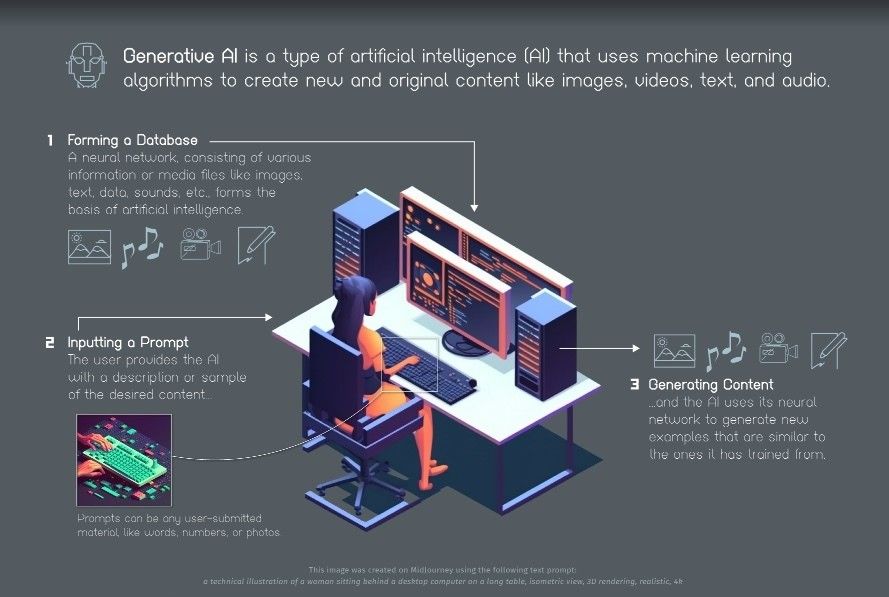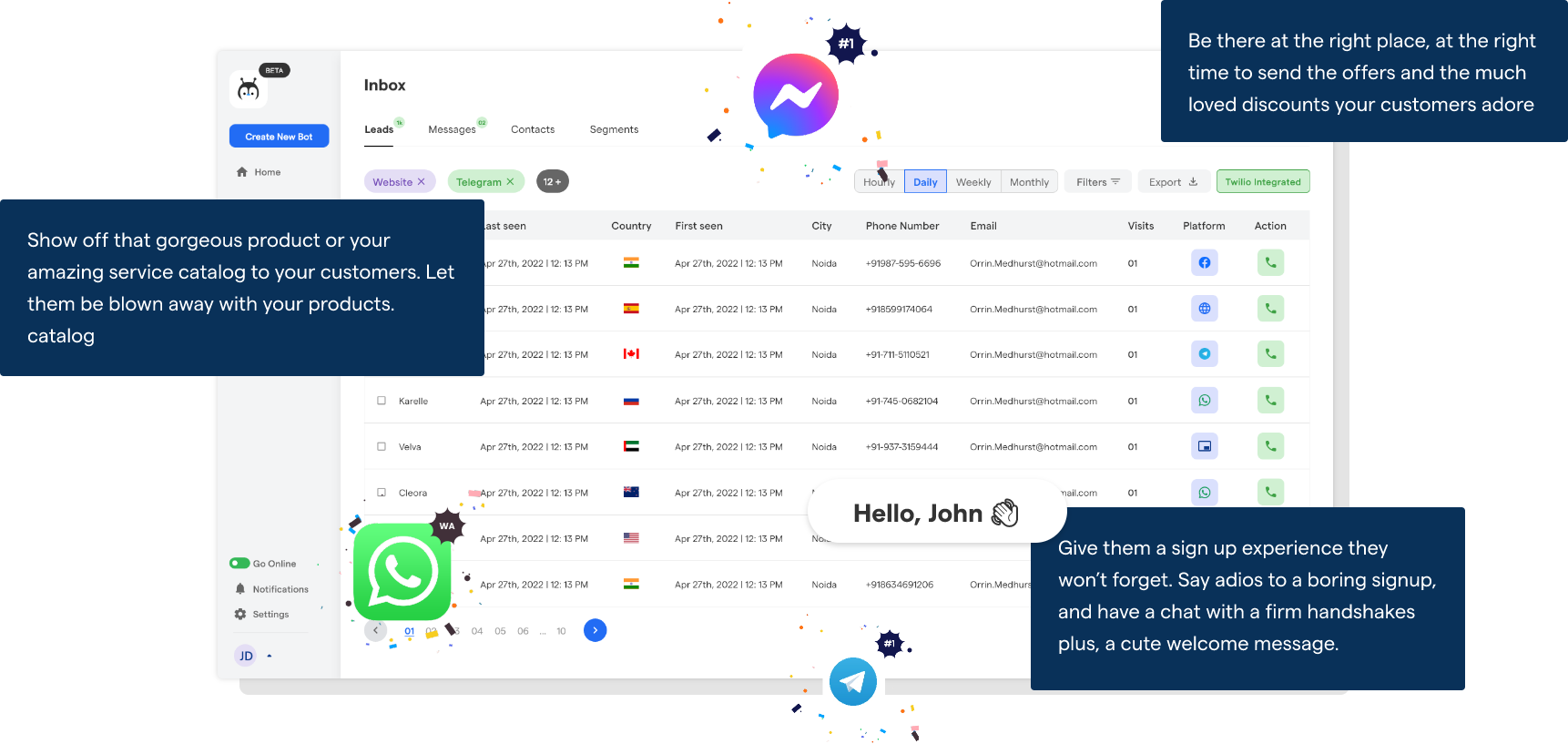Generative AI is transforming what computers can do - from creating original text and art to automating complex tasks. These models learn patterns from massive data to generate fresh, high-quality output with applications limited only by imagination.
According to a McKinsey survey, 50% of organizations have adopted some form of AI, with new models seeing rapid growth.
For businesses, generative AI unlocks new levels of personalization, creativity and efficiency. ChatGPT demonstrates interactive abilities that can optimize customer experiences.
Next-gen enterprise AI can automate content writing for blogs, social media and ads to boost engagement. Text summarization AI saves workers hours distilling long reports. Innovative companies are exploring ways generative models can elevate every function.
With capabilities expanding daily, ignoring generative AI risks ceding competitive advantage to early adopters. But careful strategy is required to integrate ethically.
With responsible implementation, businesses can utilize generative intelligence to reduce costs, better understand customers and maximize human creativity.
Today's powerful models make AI advantageous for organizations of all sizes in virtually any industry. So continuing reading to know how to use Generative AI to boost your business.
What is Generative AI?

Artificial Intelligence (AI) has permeated almost every aspect of our lives, and one of its fascinating applications is Generative AI. But what exactly is Generative AI? Well, it's a branch of AI that focuses on generating new content, such as images, videos, text, and even music.
Unlike traditional AI systems, which are programmed to follow pre-defined rules, generative AI utilizes complex algorithms to create original and innovative outputs. This technology holds tremendous potential for businesses looking to stay ahead of the curve and seize opportunities in the digital age.
How does Generative AI Work?
Generative AI employs a technique called Deep Learning, which is a subset of Machine Learning. Deep Learning models known as Generative Adversarial Networks (GANs) are at the heart of this technology.
GANs consist of two components: a generator and a discriminator. The generator creates new content by generating data samples, while the discriminator evaluates those samples to determine if they are genuine or not.
Through continuous iterative training, these components work in tandem, improving the quality and realism of the generated content over time.
Benefits of Using Generative AI in Business

The rise of powerful new generative AI models like DALL-E, GPT-3, and ChatGPT is unlocking game-changing opportunities across industries. As these technologies continue advancing at a remarkable pace, more businesses are looking to leverage generative AI to boost efficiency, creativity, and performance.
Adopting these emerging capabilities strategically can deliver transformative benefits:
Enhanced Content Creation
Tools like Jasper and Copy.ai enable generating blog posts, social media captions, and other marketing and business content at scale with high quality results and customization for tone of voice. This improves consistency while greatly accelerating content production.
Faster Design Work
Generative AI design models like DALL-E, Stable Diffusion, and Midjourney can rapidly create logos, ads, merchandise, packaging, illustrations, and other visual assets. This amplifies creative capabilities for marketing and product teams.
Streamlined Customer Interactions
Customer service AI like Anthropic’s Claude can handle common inquiries, provide 24/7 automated support, and qualify sales leads - allowing staff to focus on higher value areas. Natural language processing optimizes user experiences.
Improved Market Research
Leveraging AI to analyze customer feedback, reviews, support tickets, and usage data provides powerful market insights to identify pain points and improvement opportunities. This enables data-driven product enhancement.
Enhanced Business Documents
Platforms like Anthropic can generate tailored sales proposals, contracts, presentations, and reports saving immense time. The AI adapts content and tone for each document and audience.
Personalized Recommendations
Conversational AI chatbots create tailored product recommendations for each customer using NLP to assess needs based on profiles and past behaviors. This boosts sales. BotPenguin's natural language processing is powered by advanced generative models like GPT-3 to enable human-like conversations.
Businesses can easily integrate BotPenguin bots with marketing automation tools, CRMs, payments, and other systems to streamline workflows.
By crafting ready-to-deploy AI chatbot solutions for multiple platforms, BotPenguin makes sure that your business reaches wherever your customers are:

Optimized Ad Campaigns
AI tools like Persado analyze ad performance data to generate high-converting messages tailored to different customer segments. AI optimization continually improves results.
Increased Innovation
By suggesting creative ideas at scale for new products, features, messaging, and campaigns, generative AI sparks innovation pipelines. Unique connections get formed.
When thoughtfully applied, generative AI allows enterprises to accomplish more in less time at higher quality, driving efficiency, sales, and competitiveness. Leaders must proactively explore use cases to leverage the transformational potential while managing change responsibly.
Suggested Reading:
Reshaping Education: Generative AI in Learning & Development
Key Areas for Implementing Generative AI in Business
Now that we understand what Generative AI is and its broader applications, let's explore some specific areas within businesses where this technology can make a significant impact:
Enhancing Customer Experience through Personalized Recommendations
Generative AI algorithms can analyze customer data to offer personalized recommendations, tailored to individual preferences and needs. Whether it's suggesting relevant products, personalized content, or curated experiences, this level of customization boosts customer satisfaction, increases engagement, and drives sales.
Automating Content Creation and Marketing Campaigns
Generative AI can automate content creation, reducing the time and effort required to produce high-quality outputs. From generating social media posts, blog articles, and email newsletters to developing compelling ad copies, businesses can leverage Generative AI to streamline their marketing efforts, maintain consistency, and connect with their audience effectively.
Improving Product Development and Innovation
By using Generative AI, businesses can explore new design possibilities and optimize product development processes. Generative AI can assist in generating and evaluating design prototypes. It enhances overall product quality and innovation while reducing time-to-market.
Streamlining Operations and Optimizing Processes
Generative AI can automate tasks within an organization, such as data entry, report generation, and workflow optimization. By streamlining operations, businesses can redirect resources towards more strategic initiatives while improving overall efficiency, accuracy, and productivity.
Steps to Implement Generative AI in Your Business
To successfully integrate Generative AI into your business, you need a well-defined plan and a solid foundation. Let's explore the key steps involved in implementing Generative AI in your business.
Step 1
Identify Your Business Needs and Goals
Before diving into the world of Generative AI, it's crucial to clearly identify your business needs and goals. Ask yourself: what challenges are you trying to address? What specific outcomes are you aiming to achieve? Whether it's enhancing customer experience, automating content creation, or improving product development, understanding your objectives will guide your implementation strategy.
Step 2
Choose the Right Generative AI Platform or Solution
Once you have a clear vision of your business needs, it's time to choose the right Generative AI platform or solution. There are various options available, each with its own strengths and capabilities.
Assess different platforms based on factors such as ease of use, scalability, support, and integration capabilities. Consider whether you require on-premise or cloud-based solutions, and ensure that the platform aligns with your business requirements.
Platforms like BotPenguin provide intuitive drag-and-drop chatbot builders for popular platforms like WhatsApp, Facebook Messenger, Website, and more. Our natural language processing is powered by advanced generative models like GPT-3 to enable human-like conversations.

Step 3
Data Collection and Preparation
Generative AI relies heavily on data. To train the AI model effectively, you need high-quality and diverse data. Start by collecting relevant data from reliable sources, both internal and external to your organization. Ensure that the data is clean, well-annotated, and properly structured.
Data preparation is a critical step that involves cleaning and preprocessing the data to remove noise and inconsistencies. Remember, the quality of your data directly impacts the accuracy and effectiveness of your Generative AI model.
Step 4
Training and Fine-tuning the Generative AI Model
Training your Generative AI model is where the magic happens. This step involves feeding your prepared data into the model and allowing it to learn patterns and generate new content. Start with a small subset of data and gradually increase the complexity as your model improves.
Fine-tuning is an iterative process where you continuously evaluate and adjust the model's performance. Keep an eye on metrics such as accuracy, diversity, and realism to ensure that the generated outputs align with your business goals.
Step 5
Integration and Deployment
Once your Generative AI model is trained and fine-tuned, it's time to integrate it into your existing business processes. This step involves developing APIs or interfaces that allow your model to interact with other systems and applications.
Consider factors such as scalability, performance, and security during the integration process. Test the integration thoroughly to ensure smooth operation, and document the implementation to facilitate future maintenance and updates.
Potential Challenges and Considerations
While Generative AI offers immense potential, it's important to address some key challenges and considerations:
Ethical implications and concerns of generative AI
Generative AI raises ethical concerns related to intellectual property rights, plagiarism, and misinformation. It's essential to create a clear framework and guidelines to ensure that the generated content respects copyright laws and ethical standards.
Privacy and data security considerations
Collecting and utilizing data for Generative AI introduces privacy and data security risks. Implement robust data protection measures to safeguard sensitive information and comply with privacy regulations. Consider data anonymization techniques and ensure transparent communication with users about data usage.
Addressing bias and ensuring fairness in AI-generated outputs
AI models, including Generative AI, can inadvertently exhibit bias, leading to unfair or discriminatory outputs. Proactively work to identify and mitigate biases in your training data and model outputs. Regularly monitor and evaluate the fairness and inclusiveness of your Generative AI system.
Training and upskilling employees for AI implementation
Integrating Generative AI into your business requires a skilled workforce. Invest in training programs and upskilling initiatives to equip your employees with the necessary knowledge and expertise. Foster a culture of continuous learning and empower your teams to leverage Generative AI effectively.
Conclusion
The rise of powerful generative AI brings immense opportunities for businesses to operate smarter and outpace competitors. Technologies like DALL-E, Copy.ai, and ChatGPT enable teams to create, write, and communicate at new levels of speed, scale, and consistency.
However realizing the full advantages requires thoughtful implementation and integration tailored to your specific business needs and workflows. The strategies covered in this guide provide an actionable roadmap to incorporate generative AI in impactful ways - from streamlining content and ads to optimizing customer interactions.
While the capabilities are impressive, effectively leveraging these emerging technologies in your organization remains non-trivial. That's where platforms like BotPenguin can help.
BotPenguin makes it easy to build and deploy intelligent chatbots enhanced by generative AI across all digital channels - no coding required.
The right solutions enable any business to tap into the transformative potential of AI. With BotPenguin's innovative yet easy-to-use solutions, unlocking the benefits of generative AI for impactful customer experiences is possible for any business.
Suggested Reading:
Frequently Asked Questions (FAQs)
How to actually get started with generative AI in your business?
Begin by assessing your specific business needs, understanding available generative AI tools, and identifying potential use cases. Consider collaborating with AI experts or leveraging user-friendly platforms to kick-start implementation.
How do you implement generative AI?
Implementation involves defining clear objectives, selecting appropriate AI models, gathering relevant data, and training the model accordingly. Additionally, integrate the generative AI outputs into your existing business processes to drive tangible results and insights.
Will generative AI boost productivity?
Generative AI can significantly enhance productivity by automating repetitive tasks, expediting content creation, and facilitating data analysis. Its ability to generate personalized content, streamline workflows, and provide valuable insights can ultimately optimize operational efficiency and resource allocation.
How to use generative AI for marketing?
Employ generative AI for marketing by creating personalized content, generating targeted advertisements, and analyzing consumer behavior patterns. Utilize AI-generated insights to optimize marketing strategies, improve customer engagement, and tailor offerings to specific customer segments, thereby enhancing overall marketing effectiveness.



